Tutorial
Aside from simply using leather, itself, as a decorative element, there are also various means of decorating leather. While the list below may not be exhaustive, most decorated leather can probably be represented by one of, or a combination of the means in this list.
ColoringThe simplest means to decorate leather is to color it, essentially using leather as a canvas. This method is probably the oldest means of decorating leather. |
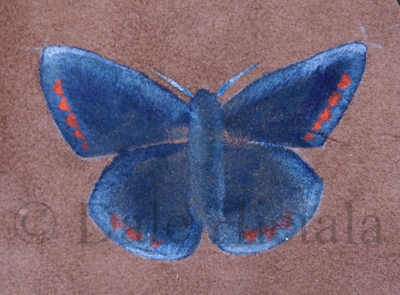
|
PyrographyPyrography is the use of heat to burn a design into the leather. This is very similar, if not identical, to burning a design into wood. Considering the cost difference between the two materials, you're more likely to find these designs in wood rather than leather. |
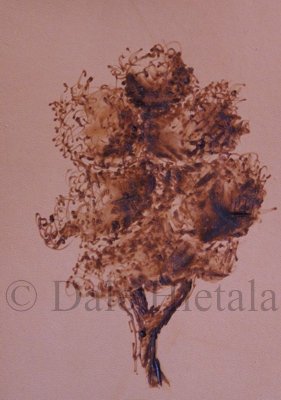
|
StampingSome people make no distinction between "stamping" and "carving". "Tooling" is another term used to identify either of these decorative methods. Still, some will distinguish stamping as the use of a mallet and stamping tools and nothing else. Stamping tools (or "stamps") are pen-shaped, typically metal, tools with designs shaped into the end. The design is placed against the leather and tapped with the mallet to make an impression of the design in the leather. The design may be recognizable as an independent design to the lay-person (i.e., a "fish") or unrecognizable (i.e., just a squiggly line). Stamping is frequently used to create geometric and basketweave patterns. |
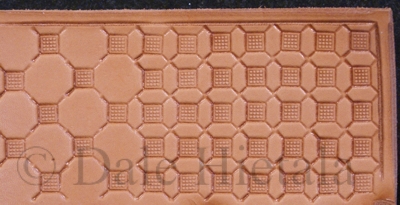
|
CarvingDismissing the argument that some consider the term "carving" to include "stamping" as defined above, carving would be described as including the use of a knife (or various knives) to actually cut into the leather as well as stamps and other tools to create various impressions in the composition of an overall design. (That being said, the use of a knife is not strictly necessary to create such a composition - lending credibility to the equality-of-carving-and-stamping debate...but I digress.) Carving is described in considerable detail in the checkbook tutorial. |
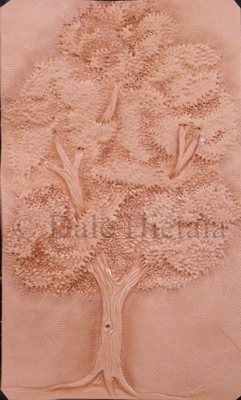
|
SculptingThere are different ways to view and define leather sculpting, and the definition you get really depends on who you ask. In the "traditional" sense (if we can actually call it that) there are two ways to sculpt with leather. The first is to laminate several pieces together and sculpt it like one would carve a block of wood. The sample here is a very basic form of this type of sculpture, though the brim is also molded. The second is to grind the leather into a powder and mix it with adhesive cement to create a clay-like substance to sculpt with. In the non-traditional sense, several of the methods listed here (and some that aren't listed here) can be combined to create what are normally considered sculpture (i.e., 3-D) pieces. Some of the best leather sculpture is done by Chan Liu Miao. Examples of his work can be seen here. |
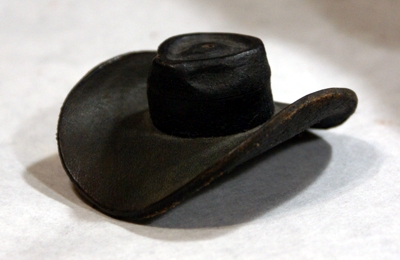
|
EmbossingThis term also means different things to different people. One of the more common interpretations is the use of a plate or roller with a design etched into it. The plate or roller is then applied to the leather under great pressure to transfer the design onto the leather. Mass-produced leather goods with imprinted designs are typically made in this manner. A more elaborate interpretation of embossing involves turning a carving (as defined above)into a type of bas-relief. The carving is stretched (typically before the piece is actually carved) and the cavity is filled. Typically, the cavity is filled with either laminated leather (shaped as required) or leather-cement mixture. Using these materials allows further contour definition in the carving once the cavity is filled. The example here shows the relief achieved with embossing. Additional relief can be achieved by appliqueing layers of embossed pieces on top of each other. |
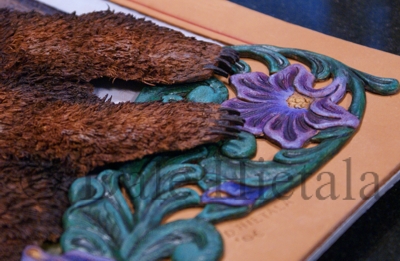
|
MoldingSince certain leather is pretty good at holding its shape, it is well suited for molding. This process involves soaking the leather and forming it around a rigid object. As it dries, it maintains the shape of the object around which it is formed. The piece here is a test piece using molding techniques. Some good examples of molding can be found at Williams Design Studio. |
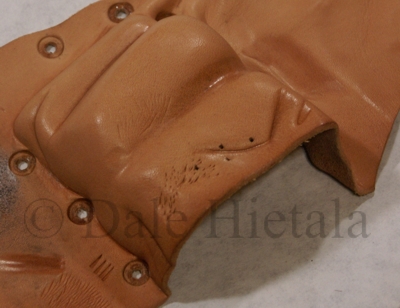
|
